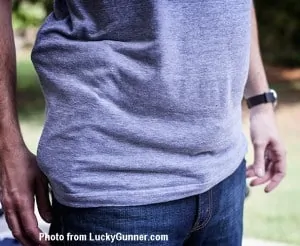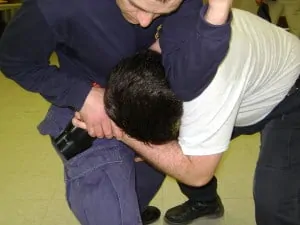Over the years we’ve trained a lot of civilians on how to carry, access, and use a firearm for self-defense. There are dozens of places to get instruction from on firearms in our State. What makes us different, though, is that we approach the training from a “Big Picture” angle. Although proficiency training is important, and a must-have, in the end the firearm is just a tool. It’s training for the situation that might require a firearm, and how it develops, that should carry as much weight, if not much more, than proficiency training alone.
Think about this; how many times have you been in, nearly been in, or been witness to a fight? Probably dozens or more. Now, how many of those have culminated into a gun-fight or should have? Probably zero, unless you’re a Police Officer. There are so many situations we find ourselves in throughout our lives where we may find ourselves being in, or getting involved in, a physical altercation as a civilian. Almost NONE of those will require deadly physical force.
Nationally as a whole, 3.6 out of 1,000 people will be a victim of a violent crime. 2.3 of those will be victims of Aggravated Assault. (http://www.fbi.gov/about-us/cjis/ucr/crime-in-the-u.s/2013/crime-in-the-u.s.-2013) Many if not most of these assaults would probably find their way into the ‘justified use of force’ category for the victim. But conversely, nearly 8 times as many will have reported being a victim of a Simple Assault, where it will be much harder to justify the use of deadly force. (http://www.bjs.gov/content/pub/pdf/cv12.pdf) You can probably safely multiply that number by 10 on how many simple assaults (fights) occur and go unreported.
Simple assault – Attack without a weapon resulting either in no injury, minor injury (for example, bruises, black eyes, cuts, scratches or swelling) or in undetermined injury requiring less than 2 days of hospitalization. Also includes attempted assault without a weapon (http://www.bjs.gov/index.cfm?ty=tp&tid=316)
None of this should be construed as us trying to minimize your decision to carry a firearm. We’re big advocates of properly trained responsible citizens being armed against evil doers. But, when you consider that you are somewhat 80 to 100 times more likely to be in a fight than you are of being a victim of an attempted Violent Crime, you must now consider how that affects your carry choices and how you are going to approach it for every day-carry.
Here are your “Big Picture” priorities for every-day carry in order of importance from 4 being pretty important, to 1 being the MOST important priority;

Gun Imprint under the shirt. This is a little dramatic to say the least. Full sized pistol in a competition holster. Most people wouldn’t dream of carrying like this. Photo, and a good article here; http://www.luckygunner.com/lounge/concealed-carry-tips-printing/
4. Concealment: Concealment ranks last in our priorities. Although important, concealment is relatively easy to achieve. And NO, we don’t care much about “Imprinting”. Imprinting or ‘printing’ is when your clothing presses against the firearm outlining it and making it clearly identifiable as a firearm. Let’s be honest, most people walk around through life pretty much oblivious to their surroundings anyway. If it’s not a glaring imprint, it probably won’t even be noticed. Have we noticed people that are clearly carrying a gun under their clothing? Of course. Did it matter? Probably not. It doesn’t to me. At least not the gun by itself. If several other factors make me uneasy about an individual, then the gun becomes just part of that equation.
The other fallacy is that if the bad guy knows you’re armed, you become a target and will shoot you first. I mean, seriously…in what context can you even begin to imagine that scenario? Movies maybe. If they are robbing a place, I don’t think they’re checking for “imprints” under shirts as they go about their drug hazed idiocy. Just don’t be overt and you’ll be fine.
Of course, the LAWS in your state may be different and you should familiarize yourself with them intimately. In some states an imprint of the firearm makes it not “concealed” and could be considered brandishing.
3. Accessibility: When needed, the firearms must be available and accessible in all positions and situations that are likely. Think again about the context of how or when you may need your firearm. Chances are it’ll be extremely stressful and with reaction time being immensely important. Trying to draw your gun from an Ankle Holster while running should make a good TV sketch and video of it will definitely get you lots of views on YouTube. Make sure you can get at it when needed, and make sure you practice doing it. Look at the ‘fist fight’ context; consider than you may be in an actual physical fight when the need to draw your firearm is presented, and that the person you are protecting yourself from is probably very close to you.
2. Comfort: Simple, if it isn’t comfortable, you won’t use it. It’s a fantastic tool but serves you little if it is left at home. The roles are littered with people that have Concealed Carry Permits that don’t carry. And many of those who get their permit let it expire and don’t renew. Arguably it’s because they don’t carry regularly, so when it expires they either don’t notice it or don’t care. Our informal polls show the two top contributing factors to why permit holders DON’T carry are Comfort and Convenience, and often those go hand in hand. Find a comfortable way to carry that allows accessibility and carry regularly to get used to it.

Photo courtesy Krav Maga New York www.kmny.us
1. Security: Here it is…your FIRST and MOST IMPORTANT consideration when deciding how to carry concealed is SECURITY. That firearm should remain exactly where you put it until YOU decide it should come out. Again a firearm is a fantastic tool. But it is not always the best tool. Either by personal choice or the lack of justification, the presentation of a firearm can be ill-advised. That doesn’t mean that there are not circumstances where you could be involved in a violent situation and not have time or space to access your weapon. For that reason alone the firearm must be secure throughout all types of physical activity, not the least of which is self-defense and fighting.
Remember, we look at the “Big Picture” in our training. That means you will rarely spend much time standing still on a line trying to make tight groupings with your rounds on paper at our training’s. It’s all about stress and dynamics. We’ve seen so many training guns fall out of perfectly good holsters during high levels of activity and even mid-levels of fight training that we HAD to put Security as the #1 priority. Can you imagine wresting around with a drunk jack-hole whom you could easily control, only to have your gun fall out on the ground right in front of their face and in their reach? No thank you. Or what if someone you’re struggling with feels your firearm under your clothes and now starts trying to get it from you? Retention is a key factor. If you aren’t able to get that part right, leave it at home.
UPDATE June 2018: By now, you may have seen the video of an FBI agent in Denver dancing at a club. As he executes a back-flip, his firearms falls out of his waistband and lands on the dance floor in plain sight of everyone. His stress takes over and he instinctively grabs for it as fast as he can to put it back in his waistband. Unfortunately stress will do bad things to your cognizance and motor skills, and as he grabs it quickly he also depresses the trigger, negligently discharging a round and hitting another patron in the leg. All other factors aside (like drinking and dancing with your firearm) we couldn’t imagine a more glaring example of why SECURITY is our number 1 priority.
For more information on how, when, and why we train, visit www.coloradokravmaga.com and www.tacticalkm.com and like our Facebook page to receive updates and notices of training seminars as they become available.
